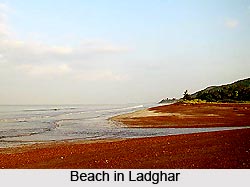 Ladgahar is a place of prominent tourist importance. It is a place of worth visiting that will refresh the spirit of ones. Ladgahar is becoming popular for its nice and pristine beach.
Ladgahar is a place of prominent tourist importance. It is a place of worth visiting that will refresh the spirit of ones. Ladgahar is becoming popular for its nice and pristine beach.
Tourism in Ladgahar
Ladgahar has an unspoiled landscape beauty, which will refresh the spirit and recharge your energies. This beach is known as "Tamas Teertha" as some part of the sea appears to be red in colour.
Ladgahar beach has religious value and the bathing in Arabian Sea at Ladgahar Beach is a big attraction to the pilgrims. It is also a great spot for swimming, either in the sea or in the adjacent area where a river empties into the Arabian Sea.
Some part of Ladgahar is covered with coloured pebbles and boulders. It is creating a beach-rock collector`s paradise. For those wanting a more strenuous walk this is a spectacular piece of coastline.
In Ladgahar there lies a temple called Veleshwar Temple. The area is undeveloped, has an untouched feel and is beautiful around sunset. Viewing of the sunset here is a breathtaking experience as the Ladgahar beach; sea and the horizon get bathed in numerous shades of red colour.
One can also participate in dolphin watching trip in boats. This beach of Ladgahar has the two beautiful, ancient temples. One of the temples is dedicated to Lord Shiva or Mahadeva known as "Veleshwar" and other of Lord Datta situated on a small hill. One can take a 15 minutes ride or to have a beach walk on the north side to reach this beautiful Datta temple.
The beautiful sunset at Ladghar is worth visiting. If one wishes to enjoy mouth watering, delicious fish food then Ladghar is the place for him. It houses some really good resorts famous for serving fresh fishes in local cuisine. On the south side of the beach is a small fishing village called Burondi. The fishing boats with their twinkling lights make the Burondi harbour a fascinating sight to watch in the evenings.
Visiting Information
Ladghar is situated around 8 kilometers from Dapoli, which is not very far from Mumbai, Maharashtra. The State Transport (ST) buses and the private shared jeeps, rickshaws run between Dapoli and Ladghar. One can hire an auto rickshaw or drive down. The rented jeeps / cars are available. If one wishes to go Ladgahar by bus, one need to reach from Dapoli. Then he needs to come to Borondi, which is known for fish market in Maharashtra, leads to Ladghar.



















